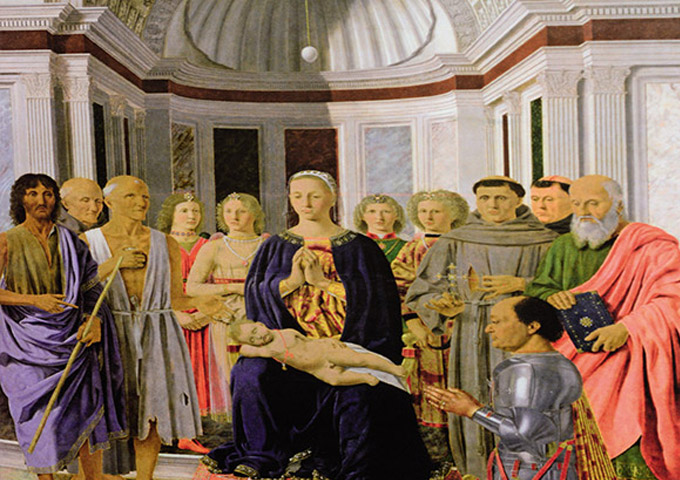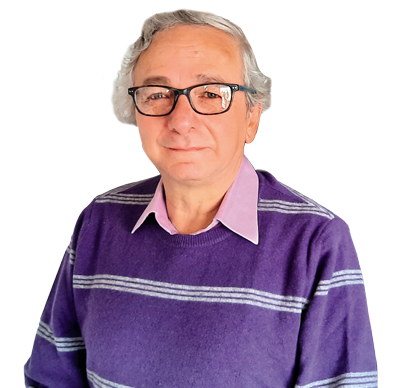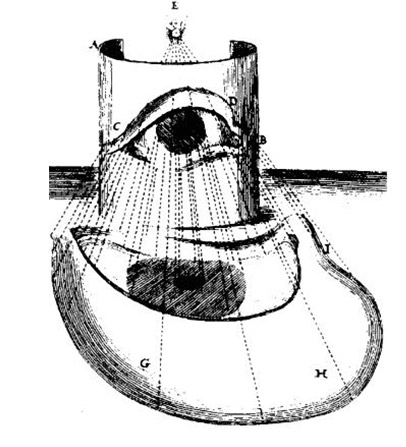Research that restored 23 centuries of history
By: Ángela Constanza Jeréz Trujillo
Photos:
Society and Culture

By: Ángela Constanza Jeréz Trujillo
Photos:
Let us consider a common situation. A person sits on a meadow and puts a book within arm’s reach. On the horizon, he sees a group of trees behind which there is a mountain. He looks up and the blue and white sky appears. If he looks down again, the book and the green meadow reappear, and if he turns to the right, the objects on the left edge disappear.
It seems simple, but for around 23 centuries, various thinkers from different disciplines and parts of the world have dedicated years of their work to understand why this happens. How is it possible that a scene from the outside world settles inside us? What happens in our eyes and mind so that that the wonderful fact of seeing and grasping the objects that appear before us takes place?
““Whenever men find a mystery that deeply disturbs them, they don’t just stare at it, but rather want to unravel it somehow. It has not been easy to study a phenomenon of this style. It has been a very complex task. We have been trying for many centuries to come up with a unified and complete theory,” explains Carlos Alberto Cardona, professor at the School of Human Sciences of the Universidad del Rosario.
This doctor of philosophy, with a master’s in physics teaching, dedicated the last 10 years of his academic life to making a rational reconstruction of the use of the visual pyramid. With this instrument, an attempt has been made to explain the phenomena associated with visual perception.
In other words, Professor Cardona traveled through all those centuries to compile the tension between the best theories that have tried to understand the task of visual perception. He followed the methodology of Imre Lakatos, Hungarian philosopher and mathematician. Its normativity is known as the methodology of research programs and involves tracking a set of theories that unfold over long periods.
In case of visual perception, the starting point of the research was the visual pyramid, created by Euclid in the 3rd century BC. “This consists in imagining that the visible face of the object we are contemplating is the base of a pyramid and that the observer is located at the vertex of the pyramid. Also, between object and observer there is a rectilinear mediation. We imagine that seeing is deciphering the geometric keys offered by the pyramid. By deciphering these keys, we can see the dispositions and properties of the objectives that we imagine beyond the visual field,” explains Professor Cardona.
In reconstructing the theories, the professor carefully monitored the tension, obstructions, and solutions that have arisen over time regarding the use of the instrument created by Euclid.

Professor Carlos Cardona has researched several centuries to compile the tension between the best theories that attempted to understand the task of visual perception.
Problems and solutions
The book that condenses the count of so many years of history will come out this semester. In eight chapters, Cardona and the team of students who accompanied him in the research point out different tension. For example, the first and most obvious, which was indicated almost four centuries after the pyramid was created, refers to the fact that it serves to explain the vision achieved by one eye, but we as humans have two.
“We might think that Euclid’s instrument is highly interesting for one-eyed observers, but we are observers who grasp the world with two eyes. This slight difficulty demands that, if we are going to continue using the instrument, we have to make modifications to its use,” explains Professor Cardona with humor.
Claudius Ptolemy, Greek-Egyptian astronomer, mathematician, and geographer, proposed the modifications to attend to such difficulty without abandoning the instrument. He showed that visual perception can be conceived if we use two pyramids instead of one. One attached to the left eye and the other to the right eye. The question he posed was how do we manipulate two visual pyramids? The answer that he found was to replace the two independent pyramids with a virtual pyramid, for which it would be necessary to imagine that the vertex is almost at the origins of the nose, between the middle point of the two eyes.
“Then the theorems that Euclid had developed for visual perception could be referred to a cyclops eye that is located at the base of the nose. With this answer, the instrument was successful, without abandoning its fundamental prescriptions,” explains the professor.
Over the years, the reflections of the thinkers regarding the use of the visual pyramid became more complex and, with it, the deductions. Thus, the second difficulty with which the reconstruction deals is that visual perception cannot end at a geometric point because the observer could not perform his/ her tasks if he/she thus restricts his/her position. “The reason for this is very simple," says Cardona. “If all the information ended in a geometric point, the observers would not be able to discern between different objects in front of them.
These assertions led to another element on the table: The structure of the eye. Geometry was not enough to explain visual perception; you had to refer to physiology. The first thinker to deal with the subject was the Arab mathematician, physicist, and astronomer known in the West as Alhacén. He did it in the 10th century AD when he undertook the task of recovering all the anatomy that Galen, Greek physician and philosopher, had conceived for the eye in the second century AD, but he did it with an additional element: He dealt with the geometric functionality of each of the crystalline parts of the eye. “In this way, Alhacén warned that we have a cornea, behind the cornea, there is a small lens called the crystalline lens and behind it, there is vitreous humor. He thought about the geometric functionality of each of these spheres and asked a question: Where is the place where all the information should be collected since we cannot expect it to converge in a geometric point?” Professor Cardona clarifies.
That meant that the place of reception of the information is not the vertex of the pyramid but somewhere either before or after the vertex. Alhacén pointed out that it could not be behind because we would see inverted, so the place had to be before the vertex of the visual pyramid and the back face of the lens.

The painters also contributed to the notions that were given through the centuries in relation to visual perception. Professor Cardona explains in his book that Italian Renaissance painters, although not interested in the theoretical aspects of visual perception, made contributions that, in the end, turned out to be of the greatest importance.
Paintings’ contribution
Painters also contributed to the notions that were given through the centuries in relation to visual perception. Cardona explains in his book that Italian Renaissance painters, although not interested in the theoretical aspects of visual perception, made contributions that, in the end, turned out to be of the greatest importance. Their interest in achieving good pictorial copies on canvas, so that those who contemplated their paintings imagine that they were seeing objects displayed in three dimensions, led to the concept of linear perspective.
Alberti supposed that, if the visual pyramid conceived by Euclid was cut somewhere by a pictorial veil, the painter had to reflect on his canvas how the visual pyramid was interrupted by the location of that canvas. "Alberti, Piero della Francesca, and Leonardo da Vinci took on the task of developing geometric keys that could geometrically anticipate how that break or that crossing of the Visual Pyramid with the pictorial veil would have to be designed," Cardona adds.
After the rise of Renaissance painting, some thinkers saw a key to understanding visual perception. Their proposal consisted in imagining that in the process of visual perception the human being should have a pictorial copy of the objects that are outside, with the hope of imagining that there is a picture collected in the visual apparatus so that the observer can decode it with the same techniques, applied in the opposite direction, of the visual perspective of Renaissance painters.
In the 17th century, two centuries after the Renaissance painters, Johannes Kepler, German astronomer and mathematician, offered the most robust synthesis of the research program. He showed that the place where pictorial scenes are collected is the retina. This result led to a new difficulty in the use of Euclid’s instrument: It had to be considered that the expected mediation does not occur in a rectilinear manner since the light breaks when passing from the air to the cornea, it again breaks when passing from this to the intermediate fluid and again when it passes through the vitreous humor, all on account of the refraction of light. The astronomer warned that if it is light that mediates between the object and the observer, it is not true that it follows straight paths.
This deduction led to modifying the instrument or creating a law to understand how much the light was breaking. Kepler devised a law that, while wrong in the light of modern optics, led to a central result in the research program. Cardona calls this result the fundamental theorem of optics. “With a wrong refraction law, which is irrelevant to judge, Kepler managed to warn that, if there is a light source outside and it passes through the crystalline spheres, it converges at a point inside the eyeball. If that point is on the retina, then the contemplation of the object is clear; if not, it would be blurry. This theorem allowed us to admit that the retina is where the pictorial veil that copies an image from the outside is found,” says Cardona.
For some, this theorem is pure poetry, because it is imagining that the light beams touch the retina as if they were brushes. With this, Kepler introduced a distinction that later will be extremely important, which is the distinction between painting and image. What is happening in the retina is the reception of a painting, but what the mind is observing, or whoever is dealing with that painting, is observing an image. We are not aware of observing something that happens in the retina,” adds the professor. Despite all these reflections, Kepler failed to understand, and today the world still does not understand, how the process, by which the human being has the contemplation of a mental scene from the two pictorial copies, is one of the left eye and another of the right.
The professor presents the entire reconstruction in a book that will soon appear, which will be published by the Universidad del Rosario. In addition, it has a microsite, published on the website of the School of Human Sciences, where readers can follow the modeling of the geometric figures that the authors have prepared in the GeoGebra software. This is a recommended place for those interested in this important topic.
The research project The visual pyramid: Evolution of a conceptual instrument, carried out by Professor Carlos Alberto Cardona, had the support of the School of Human Sciences and the Vice Provost’s Office of Research and Innovation of the Universidad del Rosario.
In addition to the book, which became available in the second semester of 2020, those interested in delving into this relevant account of the theories around the visual pyramid can consult the virtual microsite of the project at the university. It contains the files that model the geometric figures on which a good part of the book’s arguments is supported.
The geometric arguments have been modeled with the Cabri II plus, Cabri 3-D dynamic geometry software, and the free GeoGebra software. To understand the role of each model, the reader must follow the general and specific instructions and have the book close by, which can be purchased at the Universidad del Rosario publishing house stores and at the country’s bookstores. Articles published in relation to the project and a video presentation of the project are also available on the microsite. (https://urosario.edu.co/Escuelade- Ciencias-Humanas/Investigacion/ Lapiramide-visual/index.html).